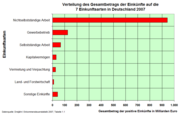Type of income (Germany)
The German Income Tax Act recognizes seven types of income , which are finally listed in Section 2 Paragraph 1 Sentence 1 No. 1 to 7 EStG ( numerus clausus ). According to Section 2 (2) EStG , a distinction is made between profit income and surplus income , which is accompanied by different calculation methods and criteria ( dualism of income determination ). Income that cannot be assigned to any of these types of income is not subject to income tax, for example lottery or other game winnings. However, these can be covered by other types of tax .
| Income type | legal basis |
|---|---|
| Profit income | |
| Income from agriculture and forestry | § 13 , § 13a , § 14 , § 14a EStG |
| Business income | § 15 , § 16 , § 17 EStG |
| Income from self-employment | § 18 EStG |
| Excess income | |
| Income from employment | Section 19 EStG |
| Income from capital | Section 20 of the Income Tax Act |
| Rental and leasing income | Section 21 of the Income Tax Act |
| Other Income | § 22 , § 23 EStG |
history
After the taxable income concept had previously been derived from the net wealth access theory , the income tax law has known the final list of types of income since 1925. The list has remained unchanged since the National Socialist reform in 1934.
Profit income
Income as profits is determined either through a complete or incomplete comparison of business assets at the end of the year or through an income statement. However, the income surplus calculation is only permitted if the taxpayer is not obliged to keep books and also voluntarily does not keep books and does not close any financial statements.
A special regulation applies to farmers and foresters who can apply average rates in accordance with Section 13a EStG.
Constituent elements
Prerequisite for the present profit income are the constituent elements of profit , sustainability , independence and participation in the general economic traffic. The latter arises as soon as services are offered for a fee that are recognizable to third parties. If there is no intention to make a profit, it is a hobby .
Excess income
Income as surpluses is determined by comparing income and income- related expenses ( §§ 9 to 9c EStG). The concept of advertising expenses is not to be equated with business expenses, but rather more narrowly.
With the exception of private sales transactions that are attributable to other income in accordance with Section 23 of the Income Tax Act and the sale of capital assets in accordance with Section 20 (2) of the Income Tax Act, only regular income from a source of income is considered taxable (source concept).
Quantitative importance
The triennial income tax statistics 2007 (published on January 27, 2012) show the distribution across the seven types of income:
See also
Individual evidence
- ↑ Gierschmann, Gunsenheimer, Schneider: Textbook income tax (15th edition), page 83, ref. 66/67


